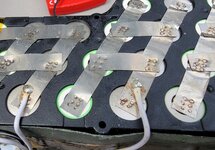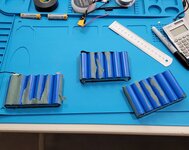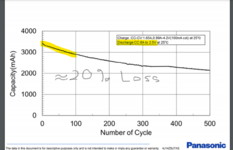George S.
Well-Known Member
Why Do Packs Fail?
I bought 4 9ah LiFePo4 packs, rated at 12 volts. These packs were old and used. When I tested the 4 packs, they ranged from 6.4 amp hours to 7.7 amp hours. With different capacities, and 4 in series to make a 48 volt pack, you have to charge and discharge for the weak module. If you try to run the 6.4 amp hour module to 7 amps, the voltage will explode over the max, because it is fully charge. In the discharge phase, pushing the low capacity cell will drive the voltage down and ultimately kill the module. I tried to manage the charging but it was impossible. The weak module seemed to be really messed up. So I took it apart.
The theory I had was that the cells in these 4 modules were all ‘good’ but tired, so instead of 9 ah they had 6 or 7 amp hours. This is totally normal. When I took the modules apart, I found something completely different. There were 24 cells, and about 6 were essentially dead, very low voltage and no charge capability. And the other 18 cells weren’t really weak. They had capacities close to the nominal 1500 rating, maybe 1400 mah. I was surprised the module even worked as an ebike pack. It was impossible to keep it from overcharging and overdischarging, with 3 other modules in series. Plus this pack was not holding voltage well, at all, under load.
In this case the cause of the pack failure was revealed by tearing the pack apart and running capacity tests, charge and discharge, on 24 cells. That is a bit of work. In the end, what can be done? Getting 24 cells out of the welded configuration means tearing the nickel off, cell by cells, top and bottom. There’s no way to check the viability of a cell in the welded configuration. You have 6 cells in parallel, so that is the voltage you will get, that’s the smallest unit. Even if you could find a bad cell, or set of bad cells, then what? You can’t remove a cell from the matrix of nickel strips. Many people have yearned after a system where the cells could be removed, but it’s not really a tech that is out there.
If a pack stops working, do you toss it, recycle it? Well, it may be easy to remove all the (welded) cells from a plastic case, and see if there is any obvious problem. There are usually balance wires which isolate the parallel sets, and these wires go to the BMS. The BMS may have failed. You can trace power to the BMS, from the positive and negative sides, measure the voltage, see if the circuit will supply amps. You can check the balance, on each balance lead. You can check balance leads with the battery under load, as you reach discharge levels.
Batteries fail. Circuits fail, like a break in the nickel strips or internal wiring. BMS units fail or become erratic. Fuses blow. Cells short out or explode, but it’s not that common. I don’t know why a cell stops working and I’m not sure what the hazard is. These are relatively non-volatile LFP cells.
The final forensic procedure is the least attractive. Basically you take the pack apart to get at the individual cells, and test each cell looking for a pattern of dead cells or very low capacity cells. I’m not making an exhaustive list. I’m giving you a DIY’er perspective on the real world, but nothing more than a narrow slice. I have the time to just goof around with this stuff, though I tend to work outside, wear gloves, all that stuff.
There are ways to deal with this problem, that packs aren’t easy to analyze, or autopsy. There’s no real fix for many problems. Maybe there are two extreme ways to deal with the problem, with other strategies in between the extremes. Strategy #1) make batteries that are good enough, but super cheap. Or, (2): Go super tough, like bulletproof, but at a gold plated price. I can point to both, with examples, but there are so many other issues. If you buy an ebike with a battery, you don’t actually know which approach your seller uses. Strategy #1 means: If the cheap pack fails, it’s easier to just replace it. The bulletproof battery isn’t supposed to fail, so the seller should offer a multi year warranty. If the $100 Liito Kala pack is here to stay, totally automated mass production, it’s pretty attractive. I’m still using their hundred dollar special, four months, many cycles. If the pack failed in the next year, I would still take it apart, separate out all the cells, just to see if they were usable, or to see what might have gone wrong.
I have a Luna pack from their early years. I took it out of the case last week and threw out the BMS, which kept shutting down. Looking at the raw welding I’m not sure I should be totally pleased. See first picture. Second pic is the LFP pack partly disassembled.
I bought 4 9ah LiFePo4 packs, rated at 12 volts. These packs were old and used. When I tested the 4 packs, they ranged from 6.4 amp hours to 7.7 amp hours. With different capacities, and 4 in series to make a 48 volt pack, you have to charge and discharge for the weak module. If you try to run the 6.4 amp hour module to 7 amps, the voltage will explode over the max, because it is fully charge. In the discharge phase, pushing the low capacity cell will drive the voltage down and ultimately kill the module. I tried to manage the charging but it was impossible. The weak module seemed to be really messed up. So I took it apart.
The theory I had was that the cells in these 4 modules were all ‘good’ but tired, so instead of 9 ah they had 6 or 7 amp hours. This is totally normal. When I took the modules apart, I found something completely different. There were 24 cells, and about 6 were essentially dead, very low voltage and no charge capability. And the other 18 cells weren’t really weak. They had capacities close to the nominal 1500 rating, maybe 1400 mah. I was surprised the module even worked as an ebike pack. It was impossible to keep it from overcharging and overdischarging, with 3 other modules in series. Plus this pack was not holding voltage well, at all, under load.
In this case the cause of the pack failure was revealed by tearing the pack apart and running capacity tests, charge and discharge, on 24 cells. That is a bit of work. In the end, what can be done? Getting 24 cells out of the welded configuration means tearing the nickel off, cell by cells, top and bottom. There’s no way to check the viability of a cell in the welded configuration. You have 6 cells in parallel, so that is the voltage you will get, that’s the smallest unit. Even if you could find a bad cell, or set of bad cells, then what? You can’t remove a cell from the matrix of nickel strips. Many people have yearned after a system where the cells could be removed, but it’s not really a tech that is out there.
If a pack stops working, do you toss it, recycle it? Well, it may be easy to remove all the (welded) cells from a plastic case, and see if there is any obvious problem. There are usually balance wires which isolate the parallel sets, and these wires go to the BMS. The BMS may have failed. You can trace power to the BMS, from the positive and negative sides, measure the voltage, see if the circuit will supply amps. You can check the balance, on each balance lead. You can check balance leads with the battery under load, as you reach discharge levels.
Batteries fail. Circuits fail, like a break in the nickel strips or internal wiring. BMS units fail or become erratic. Fuses blow. Cells short out or explode, but it’s not that common. I don’t know why a cell stops working and I’m not sure what the hazard is. These are relatively non-volatile LFP cells.
The final forensic procedure is the least attractive. Basically you take the pack apart to get at the individual cells, and test each cell looking for a pattern of dead cells or very low capacity cells. I’m not making an exhaustive list. I’m giving you a DIY’er perspective on the real world, but nothing more than a narrow slice. I have the time to just goof around with this stuff, though I tend to work outside, wear gloves, all that stuff.
There are ways to deal with this problem, that packs aren’t easy to analyze, or autopsy. There’s no real fix for many problems. Maybe there are two extreme ways to deal with the problem, with other strategies in between the extremes. Strategy #1) make batteries that are good enough, but super cheap. Or, (2): Go super tough, like bulletproof, but at a gold plated price. I can point to both, with examples, but there are so many other issues. If you buy an ebike with a battery, you don’t actually know which approach your seller uses. Strategy #1 means: If the cheap pack fails, it’s easier to just replace it. The bulletproof battery isn’t supposed to fail, so the seller should offer a multi year warranty. If the $100 Liito Kala pack is here to stay, totally automated mass production, it’s pretty attractive. I’m still using their hundred dollar special, four months, many cycles. If the pack failed in the next year, I would still take it apart, separate out all the cells, just to see if they were usable, or to see what might have gone wrong.
I have a Luna pack from their early years. I took it out of the case last week and threw out the BMS, which kept shutting down. Looking at the raw welding I’m not sure I should be totally pleased. See first picture. Second pic is the LFP pack partly disassembled.




